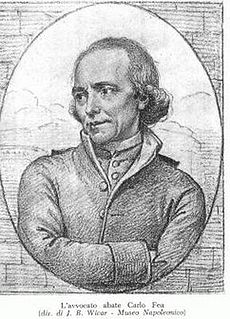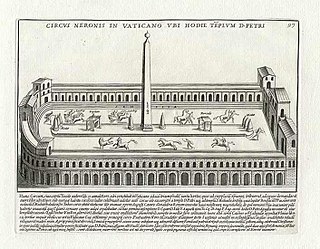This page is based on this
Wikipedia article Text is available under the
CC BY-SA 4.0 license; additional terms may apply.
Images, videos and audio are available under their respective licenses.

Carlo Fea was an Italian archaeologist.

Pietro Santi Bartoli was an Italian engraver, draughtsman and painter.

Antonio Cavallucci was an Italian painter of the late Baroque.

Antonio Randa was an Italian painter of the classicist period, active in Ferrara, Modena, Rovigo, Florence, Comacchio and his native Bologna.

Hermonax was a Greek vase painter working in the red-figure style. He painted between c. 470 and 440 BC in Athens. Ten vases signed with the phrase "Hermonax has painted it" survive, mainly stamnoi and lekythoi. He is generally a painter of large pots, though some cups survive.

Paolo Orsi was an Italian archaeologist and classicist.
Mario Donizetti is an Italian painter, essayist from Bergamo, Lombardy.

Pelagio Palagi was an Italian painter, sculptor and interior decorator.

Chalcidian pottery is an important style of black-figure Greek vase painting.
Albano Lugli was an Italian painter and ceramic artist mainly active in his native Carpi, painting historic and sacred subjects.

Simone di Filippo Benvenuti, known as Simone dei Crocifissi or Simone da Bologna, was an Italian painter. Born and dead in Bologna, he painted many religious panel paintings, and also frescoes in the churches of Santo Stefano and San Michele in Bosco, both at Bologna.

Giuseppe Amisani was an Italian portrait painter of the Belle Époque.
Igino Benvenuto Supino was an Italian painter, art critic, and historian.

The Painter of the Berlin Dancing Girl was an Apulian red-figure vase painter who was active between 430–410 BC. He was named after a calyx krater in the collection of the Antikensammlung Berlin which depicts a girl dancing to the aulos played by a seated woman.

Juti Ravenna was an Italian painter.
Raffaele Armenise was an Italian painter and scenographer, mainly painting history and genre subjects.
Antonio Longo was an Italian painter and priest in a late Baroque style.
Marcello Landi (1916-1993) was an Italian painter and poet.

The necropolis of Santu Pedru is an archaeological site of the municipality of Alghero, Sardinia.
















